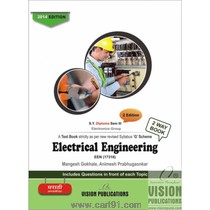


लेखक अनिमेश प्रभुगावकर, मंगेश गोखले
भाषा इंग्रजी
आयएसबीएन १३
संस्करण २
प्रकाशित वर्ष २०१४
पुस्तकाचे स्वरूप
प्रकाशक विजन पब्लिकेशन
1.AC Fundamentals
1. Introduction
2. Difference between AC and DC quantity
2.1 Alternating Current
2.2 Direct Current
3. Advantages of AC Supply over DC
4. Waveform of Sinusoidal AC Cycle
5. Generation of Single Phase AC by Elementary Alternator
5.1 Construction
5.2 Working Principle
6. Definitions related to Alternating current
6.1 Peak Factor (Crest Factor)
6.2 Form Factor
6.3 Equation of a Sinusoidal Waveform
Solved Examples
7. Vector Representation of Sinusoidal AC Quantity
7.1 Phasor Algebra
7.2 Conversion from Add to Polar and vice versa
Solved Examples
8. Concept of Phase
8.1 Concept of Lagging and Leading
8.2 Mathematical Equations of Phasors
Solved Examples
8.3 Single Phase AC circuit
9. Purely Resistive AC Circuit
Solved Example
10. Purely Inductive AC Circuit
10.1 Inductive Reactance (XL)
10.2 Power in Purely Inductive Circuit
Solved Example
11. Purely Capacitive AC circuit
11.1 Capacitive Reactance (XC)
11.2 Power in Purely Capacitive Circuit
Solved Example
11.3 Comparison between Pure R, Pure L and Pure C, AC Circuit
12. Concept of Impedance and Impedance Triangle
13. Power in AC Series Circuits
14. Power Factor
15. R-L Series Circuit
16. R-C Series Circuit
17. R-L-C Series Circuit
17.1 Resonance in R-L-C Series Circuit
17.2 Resonance in Parallel Circuits
17.3 Comparison between Series and Parallel Resonance Circuit
Solved Example
2. Polyphase Circuits
1. Introduction
2. Advantages of 3-Phase System over Single Phase System
3. Principle of 3-Phase EMF Generation and its Waveform
4. Concept of Phase Sequence
5. Balanced and Unbalanced Load
5.1 Balanced Load
5.2 Unbalanced Load
6. Relations between Phase and Line Values
6.1 Relationships between Line and Phase Values in STAR Connection
6.2 Relationship between Line and Phase Values in DELTA Connection (D)
Solved Example
3. Electromagnetic Induction
1. Introduction
2. Relation between Magnetism and Electricity
3. Production of Induced EMF and Current
4. Faradays Law of Electromagnetic Induction
5. Fleming's Right Hand Rule
6. Lenz Law
7. Induced EMF
8. Energy stored in Magnetic Field
4. Single Phase Transformer
1. Introduction
1.1 Principle of Working
1.2 Construction of Transformer3
1.3 Classification of Transformer
1.4 Brief Description of Types of Transformers
2. EMF Equation of a Transformer
3. Voltage Ratio, Current Ratio and Transformation Ratio
4. kVA Rating of a Transformer
5. Losses in a Transformer
6. Efficiency of a Transformer
7. Auto Transformer
8. Applications of Transformer
Solved Example
5. Three Phase Induction Motor
1. Introduction
2. Classification of Motors
3. Three Phase Induction Motor
3.1 Principle of Working
3.2 Construction of 3-Phase Induction Motor
4. Types of Induction Motor
4.1 Squirrel Cage Induction Motor
4.2 Slip Ring or Wound Induction Motor
5. Synchronous Speed and Slip
5.1 Synchronous Speed
5.2 Slip
5.3 Rotor Frequency
6. Torque - Speed Characteristics
7. Necessity of starter
8. Speed Control Methods
8.1 Frequency Control Method
8.2 Pole Control Method
8.3 Slip, i.e., Voltage Control Methods
8.4 Speed Control of 3-Phase Induction Motor by using Silicon Controlled Rectifire / (V/f Control)/ Thyristor Control
9. Reversal of Rotation
10. Applications of Induction Motor
Solved Example
6. Fractional Horse Power Motors
1. Introduction
2. Classification of Motors
3. Single Phase Induction Motors
3.1 Schematic Representation of Single Phase Induction Motors
3.2 Principle of Operation of Single Phase Induction Motor
3.3 Types of Single Phase Induction Motors
3.4 Application of Single Phase Induction Motors
4. Universal Motor
4.1 Construction of Universal Motor
4.2 Types of Universal Motor
4.3 Principle of Operation
4.4 Speed - Torque Characteristics
4.5 Reversal of Direction of Rotation
4.6 Advantages and Disadvantages of Universal Motor
4.7 Applications of Universal Motor
5. Stepper Motor
5.1 Types of Stepper Motor
5.2 Characteristics of Stepper Motor
5.3 Applications of Stepper Motor
6. Servo Motor
6.1 Characteristics of Servo Motor
6.2 Types of Servo Motors
6.3 Applications of Servo Motors
7. Electrical Safety
1. Importance of Safety Devices
2. Types of Safety Devices
2.1 Fuses
2.2 MCCB - Moulded Case Circuit Breaker
2.3 Earth Leakage Circuit Breaker
2.4 Cables
3. Megger
3.1 Constructional Parts
3.2 Working
3.3 Use of Megger as an Earth Tester
4. Necessity of Earthing and its Types
4.1 Importance of Earthing
4.2 Classification of Earthing
4.3 Factors affecting the Value of Earth Resistance
4.4 Types of Earthing
5. Electrical Safety
solved paper of winter 2013
शैक्षणिक टप्पा
विद्याशाखा
शाखा
इयत्ता दुसरे वर्ष
सत्र
माध्यम इंग्रजी
मंडळ/विद्यापीठ पुणे
विषय